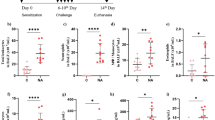Abstract
Introduction
Desmosine and isodesmosine (DID) are unique elastin crosslinks that may serve as biomarkers for elastic fiber degradation in chronic obstructive pulmonary disease. Previously, our laboratory found that the ratio of free to peptide-bound DID in bronchoalveolar lavage fluid (BALF) showed a significant positive correlation with the extent of airspace enlargement in an elastase model of pulmonary emphysema. To further evaluate this hypothesis, our laboratory measured this ratio in a bleomycin (BLM) model of pulmonary fibrosis, which involved different microarchitectural changes than those associated with pulmonary emphysema.
Methods
Syrian hamsters were instilled intratracheally with 1.0 unit BLM in 0.2 ml of normal saline (controls received the vehicle alone), and BALF was analyzed for both free and total DID, using a combination of liquid chromatography and tandem mass spectrometry.
Results
Total BALF DID was significantly increased in hamsters receiving BLM at 1 week post-treatment (92 vs 13 pg/ml; p < 0.001), consistent with elastic fiber degradation. However, in contrast to elastase-induced emphysema, free/bound DID was lower in BLM-treated animals compared to controls at both 1 week (0.76 vs 0.84) and 2 weeks post-treatment (0.69 vs 0.86), though the differences were not statistically significant.
Conclusions
These results indicate that it may be possible to identify specific pulmonary microarchitecture changes, based on the ratio of free to peptide-bound DID. It is speculated that the proportionate decrease in free DID in BLM-induced fibrosis may be due to preservation of intact elastic fibers as the lung injury progresses.






Similar content being viewed by others
References
Hogg JC, Timens W (2009) The pathology of chronic obstructive pulmonary disease. Annu Rev Pathol 4:435–459
Barnes PJ (2003) New concepts in chronic obstructive pulmonary disease. Annu Rev Med 54:113–129
Tuder RM, Petrache I (2012) Pathogenesis of chronic obstructive pulmonary disease. J Clin Invest 122:2749–2755
Turino GM, Lin YY, He J et al (2012) Elastin degradation: an effective biomarker in COPD. COPD 9:435–438
Lindberg CA, Engström G, de Verdier MG et al (2012) Total desmosines in plasma and urine correlate with lung function. Eur Respir J 39:839–845
Ma S, Turino GM, Lin YY (2011) Quantitation of desmosine and isodesmosine in urine, plasma, and sputum by LC-MS/MS as biomarkers for elastin degradation. J Chromatogr B 879:1893–1898
Fregonese L, Ferrari F, Fumagalli M et al (2011) Long-term variability of desmosine/isodesmosine as biomarker in alpha-1-antritrypsin deficiency-related COPD. COPD 8:329–333
Luisetti M, Ma S, Iadarola P et al (2008) Desmosine as a biomarker of elastin degradation in COPD: current status and future directions. Eur Respir J 32:1146–1157
Ma S, Lin YY, Turino GM (2007) Measurements of desmosine and isodesmosine by mass spectrometry in COPD. Chest J 131:1363–1371
Cantor JO, Ma SM, Turino GM (2013) What percolation theory can tell us about COPD. Med Hypotheses 81:152–155
Liu X, Ma S, Liu S et al (2015) The ratio of free to bound desmosine and isodesmosine may reflect emphysematous changes in COPD. Lung 193:329–334
Bunde A, Kantelhart JW (2005) Diffusion and conduction in percolation systems. In: Heitjans P, Karger J (eds) Diffusion in condensed matter. Springer, Berlin, pp 895–914
Redner S (2009) Fractal and multifractal scaling of electrical conduction in random resistor networks. In: Meyers PA (ed) Encyclopedia of complexity and systems science. Springer, Berlin, pp 3737–3754
Sander LM, Warren CP, Sokolov IM et al (2002) Percolation on heterogeneous networks as a model for epidemics. Math Biosci 180:293–305
Sahimi M (2009) Percolation phase transition. In: Meyers PA (ed) Encyclopedia of complexity and systems science. Springer, Berlin, pp 6538–6545
Shah D, Romero F, Stafstrom W et al (2014) Extracellular ATP mediates the late phase of neutrophil recruitment to the lung in murine models of acute lung injury. Am J Physiol Lung Cell Mol Physiol 306:L152–L161
Li B, Daggett V (2002) Molecular basis for the extensibility of elastin. J Muscle Res Cell Motil 23:561–573
Kielty CM, Sherratt MJ, Shuttleworth CA (2002) Elastic fibres. J Cell Sci 115:2817–2828
Murphy KD, Hunt GW, Almond DP (2006) Evidence of emergent scaling in mechanical systems. Philos Mag 86:3325–3338
Jesudason R, Black L, Majumdar A et al (2007) Differential effects of static and cyclic stretching during elastase digestion on the mechanical properties of extracellular matrices. J Appl Physiol 103:803–811
Nettelbladt O, Scheynius A, Bergh J et al (1991) Alveolar accumulation of hyaluronan and alveolar cellular response in bleomycin-induced alveolitis. Eur Respir J 4:407–414
Cantor JO, Turino GM (2004) Can exogenously administered hyaluronan improve respiratory function in patients with pulmonary emphysema? Chest J 125:288–292
Takahashi A, Majumdar A, Parameswaran H et al (2014) Proteoglycans maintain lung stability in an elastase-treated mouse model of emphysema. Am J Respir Cell Mol Biol 51:26–33
Cantor J, Armand G, Turino G (2015) Lung hyaluronan levels are decreased in alpha-1 antiprotease deficiency COPD. Respir Med 109:656–659
Mižíková I, Ruiz-Camp J, Steenbock H et al (2015) Collagen and elastin cross-linking is altered during aberrant late lung development associated with hyperoxia. Am J Physiol Lung Cell Mol Physiol 308:L1145–L1158
Counts DF, Evans JN, Dipetrillo TA et al (1981) Collagen lysyl oxidase activity in the lung increases during bleomycin-induced lung fibrosis. J Pharmacol Exp Ther 219:675–678
Osman M, Kaldany RR, Cantor JO et al (1985) Stimulation of lung lysyl oxidase activity in hamsters with elastase-induced emphysema. Am Rev Respir Dis 131:169–170
Doyle TJ, Pinto-Plata V, Morse D et al (2012) The expanding role of biomarkers in the assessment of smoking-related parenchymal lung diseases. Chest J 142:1027–1034
Rosenberg SR, Kalhan R (2012) Biomarkers in chronic obstructive pulmonary disease. Transl Res 159:228–237
Author information
Authors and Affiliations
Corresponding author
Ethics declarations
Conflict of Interest
None.
Rights and permissions
About this article
Cite this article
Liu, X., Ma, S., Turino, G. et al. The Pattern of Elastic Fiber Breakdown in Bleomycin-Induced Pulmonary Fibrosis May Reflect Microarchitectural Changes. Lung 195, 93–99 (2017). https://doi.org/10.1007/s00408-016-9956-2
Received:
Accepted:
Published:
Issue Date:
DOI: https://doi.org/10.1007/s00408-016-9956-2




